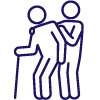- Yokohama-shi Top Page
- Asahi Ward Top Page
- Living, procedures
- Housing and Living
- Living Environment
- Consultation on the control of pests and rats
The text is from here.
Consultation on the control of pests and rats
Last updated on July 25, 2024.
Mites are usually in Tatami and Futon and live quietly, but they can occur in large quantities from a little carelessness and cause damage.
(1) There is so much damage to mites
- Stab a person
When stabbed, it turns red and turns red.……Mites - Give a sense of discomfort to others
It becomes a food for mites stabbing people……Cona mites, leopard mites (chili mites) - I have an allergy
It inhabits foottons and carpets……Leopard mites
(2) Conditions that are prone to mites
- There is a lot of food such as food fresh, dandruff, and mold.
- The temperature and humidity are high. (Temperature: 25 to 30 degrees Celsius, humidity: 60 to 80 percent)
- There are places where you can go in, such as Tatami and carpets.
(3) Important points to prevent ticks
- When the weather is nice, open windows and doors and wind through the house.
- Use a vacuum cleaner to clean frequently.
- Don't put carpets on the tatami.
- Use ventilation fans frequently to drain moisture from kitchens and bathrooms outdoors so that they do not stay inside the house.
- Do not humidify too much during heating.
(4) You can get rid of it.
If a tick occurs, do the following in addition to the prevention method.
(Thoroughly remove it with a vacuum cleaner)
- Tatami and carpets are vacuumed every day. (more than 20 seconds per half tatami mat, along the eyes)
- Bedding should be vacuumed once a week. (20 seconds or more per square meter each)
- Vacuum the corner of the room, closet, etc.
- Be sure to vacuum it after drying in the sun or drying with futon.
- Replace the dust collection pack as soon as possible.
- I recommend this kind of vacuum cleaner. (Inhaled work rate of 200W or more, paper pack type, power nozzle for carpets, futon-only nozzle for futon)
(Drying futon and tatami)
- It is dried on a sunny day. (The best is from 10:00 am to 2:00 pm after sunny weather for about 2 days. If the intake is slow, it will cause moisture.)
- Dry on hot objects such as concrete or tin roofs.
- Futon dryers are used during the rainy season.
- Tatami can also be used by a Tatami dry car (all can be removed, but it takes time and money, and the Tatami becomes brown).
Q&As
Q1 What is a mite allergen?
A1 Substances that cause allergic reactions are called "alergens." There are a lot of mites called "Leopard mites" in the house. The dung and death of this "leopard mites" are the main causes of allergic symptoms such as asthma. "Leopard mites" and their feces and death are collectively referred to as "Dani Allergens".
Q2 How can I reduce leopard mites and tick allergens?
A2 As of now, there is no effective tick killer. Even if the leopard mites can be exterminated, the feces and death that are tick allergens remain. You need to think about reducing and not increasing both leopard mites and mites allergens.
Q3 How can I reduce tick allergens?
A3 Perform the following four methods.
- Suck out
I'm sucking it with a vacuum cleaner. Carefully, patiently, and in the long run the effect comes out. Let's suck it with a vacuum cleaner efficiently using convenient goods. Don't forget that the tick allergens are deep in the back of the futon or sofa. - Rinse
Tick allergens such as feces are water-soluble. Anything that can be washed with water will be washed. Be sure to carefully determine what you can wash at home, what you rely on professionals, the material and texture. This is also a point to see if you can dry it after washing. Futon should be washed (washed) about once a year. - Contain
I'll wrap it up quickly. The "ultra-high density fiber" used in bedding has a fine fiber density, so even tick feces can be contained. The difficulty is that expenses are temporarily raised. However, it doesn't take much trouble and has a great effect. - Replace or throw away
I plunge to buy something that is hard to live in. It's also necessary to give up the extra stuff. I can't say that it's safe if it's new. It is important to determine whether the material is difficult to live in, whether it is easy to handle at home, whether it is durable, and the price is one guide.
Do you have any itchy legs in places where there are many cats, it may be fleas There are several types of fleas, but the most recent damage is cat fleas. We usually suck blood on cats, but if we leave cats, we may suck blood from humans.
(1) When blood is sucked
Itching lasts for several days
(2) Where are you?
From the egg to the puddle
Places where cats are, storerooms, floors of houses, soil and garbage under Tatami, etc.
B. adult
The skin of a cat
(3) You can get rid of it.
- Clean the place where the cat was, the storeroom, the floor of the house, and the undertami, and collect and incinerate garbage.
- Spray insecticide (flea powder).
- For domestic cats, there are flea bird collars, etc., but please consult a veterinarian.
(1) What kind of animal is a mouse
In Japan, more than 20 kinds of rats are known. There are three types of rats, rats, and rats found in and around the house.
Worm
- Inhabitants under the floor, in sewage, etc.
- Body length 220 to 260 mm
- The earlobe is thick and small
- The tail is shorter than the torso
Ikuma Rat
- They live in high places such as the back of the ceiling
- 180 to 200 millimeters long
- The earlobe is large
- The tail is longer than the torso
Rattle
- Storerooms, living in buildings
- 55-105 mm long
- The earlobe is round and large
- The tail is longer than the torso
(2) Rats are horrible
Rats are animals that not only threaten people's health, but also cause power outages and fires.
- Rat bites can cause rash, headache, and joint pain.
- It transmits Wil disease (high fever, strong jaundice, muscle pain).
- It transmits infectious diseases and food poisoning.
- Damage to food, goods, furniture, etc.
- It causes an accident by scratching pipes and wiring.
(3) A rat extermination strategy
- Do not feed - Put all food in containers and cupboards, and put garbage into containers with lids.
- Close the passage-The drains, ventilation holes, etc. should have a structure where rats cannot enter, and completely block the gaps that can become passages.
- Do not make nests- Organize unnecessary things such as cloths that are the material of the nest.
- Eliminate with equipment - generally considered inefficient, but it is quite useful in places where pesticides are not available. When using equipment, be careful not to get injured.
- Exterminating with poisonous food - it is a method of poisonous death of rats. There are acute venomers and cumulative venomers. Choose the right one depending on the type of rat.
- Check the effect - Make sure that the effect has been obtained.
- Post-processing - Spray insecticide on the place where the mouse was located, around the nest, and the death of the mouse.
(1) What symptoms do you have when you have a head lice?
Itching or scratching the skin of the head causes suppuration.
(2) You can get rid of it.
You can get rid of it by shampooing with an extermination drug (Semimi Rin powder).
- Please consult your local pharmacy for information on how to purchase and use shampoo containing extermination drugs.
(3) What are the points of prevention?
- Cut your hair as short as possible and wash it carefully.
- Avoid lending and borrowing bush, muffler, brush, etc. as much as possible.
- Let's brush carefully with a fine comb. If lice or egg gets caught on the comb, crush it and throw it away.
- Wash your pillowcases and sheets every day. It's perfect if you iron it.
(4) What are the facilities that live in a group?
- Clean common clothing and lockers well.
- Make a habit of not using people's belongings such as boshi and towels.
- Clean the changing room, dressing room, etc. well, and if necessary, remove them.
- Always overflow the pool and wash your head thoroughly with a shower before and after swimming.
Q&As
Q1 What kind of lice are there?
A1 Among the lice, there are three types of lice lice, head lice, and phee lice that sucks blood on humans.
Color lice lies in the folds of underwear, seams, etc. In today's Japan, it is not found except in special places.
Head lice does not move on to clothes by living on hair. It mainly affects infants and elementary school student in the lower grades of elementary school. On the child's head is not a pheasant lice, but a head lice.
Kergyrami parasitizes human pubic hair. It is transmitted during sexual intercourse or by lockers.
Q2 Where do you get a head lice?
A2 You can move from playing and common lockers, lending and borrowing boshis and towels, bedding, etc.
Q3 Is a head lice dirty?
A3 Children play with their bodies attached. So no matter how clean you are, you will be depressed when you go down. It's similar to getting bitten by a mosquito or scratching a case. The damage is only "Kayui", and there is no case of illness. If you find a head lice in your child, you will never panic. If you get rid of it properly, you can get rid of it in about 10 days. What you need to be aware of is that misty images such as "filthy" and "sloppy" hurt the child's heart.
Inquiries to this page
Asahi Ward Health and Welfare Center Health Sanitation Division
Phone: 045-954-6168
Phone: 045-954-6168
Fax: 045-952-1504
E-Mail address [email protected]
Page ID: 169-247-525












